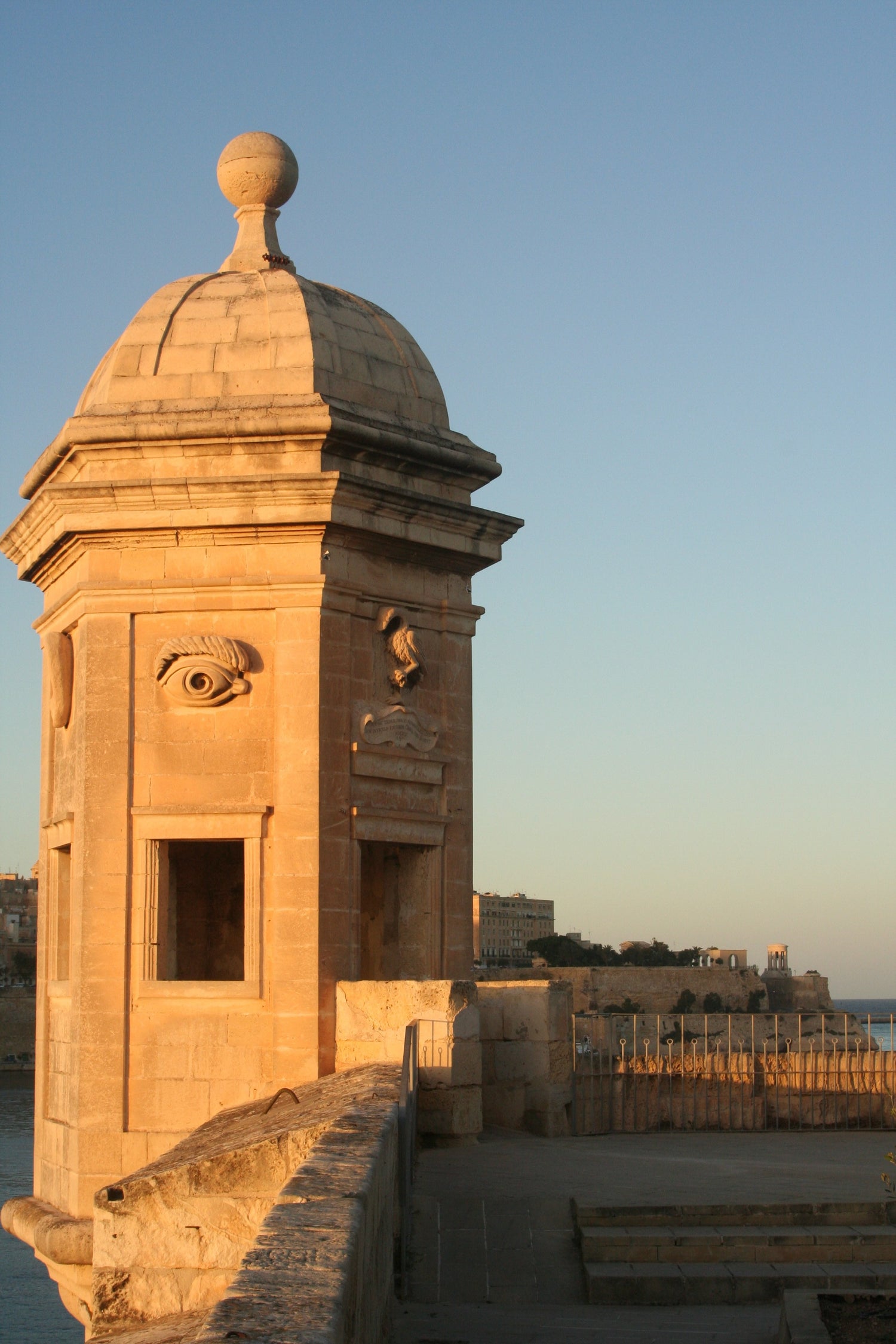Churches
I find myself repeatedly remaking the castle/ church/ cathedral form; structures I conflate as they are each establishments to seek shelter and instruction within the hierarchy of institutional power.

Architecture is a salient aspect of any culture, and Malta is no exception. It is home to some of the oldest standing structures in the world, with its neolithic temples dating back as early as 3600BC. Towering steeples and grand cathedral domes punctuate the skyline of humble limestone terraces and modest churches in larger villages and small cities. Fortresses stand audaciously along the coast as reminders of Malta’s occupied past. My sculptures attempt to make sense of my relationship to the idea of these various structures, as despite my fascination with my homeland, I have not yet seen it for myself. In a way, I may be trying to bring Malta close.
Image: Il-Gardjola Guard Tower, Senglea. Erected by the Order of St. John in the 16th Century.
My castles stand out among my body of work in both form and reference. Conceptually, they are not tied to pre-occupation Maltese culture, in fact they are opposite, modelled after emblems of British hegemony and domination by the Church. So why do I insist on including these works in my collection of symbolic objects attempting to resurrect what has been lost to time and subjugation?
Perhaps the work is an honest reflection of my own spirituality that is not devoid of Catholic influence. I grew up in a small country town in central so-called Victoria, and like any other local small country town, it somewhat revolves around Sunday mass. I dutifully served at the altar, and envisioned myself one day becoming a nun, and while I have since officially left the Church to explore my own spirituality, I still hold these memories fondly, and catch myself praying in difficult moments. I don’t reject this urge, but I do marvel at the extent of indoctrination such that something as personal as responding to grief and desperation can be so heavily influenced, that despite many years of dormancy, the rituals resurface.
Maybe in creating these cathedrals in my own organic visual language, I am reclaiming these spaces, as many have done before me. Places of worship that have survived through various foreign masters have been re-established in turn for the incumbent dominant religion, most recently Roman-Catholicism. Unlike the many times redecorated structures, my sculptures lack a clear deity of worship, and are open for personal spiritual habitation.

Image: Il-Gardjola Guard Tower, Senglea. Erected by the Order of St. John in the 16th Century.
Architecture is a salient aspect of any culture, and Malta is no exception. It is home to some of the oldest standing structures in the world, with its neolithic temples dating back as early as 3600BC. Towering steeples and grand cathedral domes punctuate the skyline of humble limestone terraces and modest churches in larger villages and small cities. Fortresses stand audaciously along the coast as reminders of Malta’s occupied past. My sculptures attempt to make sense of my relationship to the idea of these various structures, as despite my fascination with my homeland, I have not yet seen it for myself. In a way, I may be trying to bring Malta close.
My castles stand out among my body of work in both form and reference. Conceptually, they are not tied to pre-occupation Maltese culture, in fact they are opposite, modelled after emblems of British hegemony and domination by the Church. So why do I insist on including these works in my collection of symbolic objects attempting to resurrect what has been lost to time and subjugation?
Perhaps the work is an honest reflection of my own spirituality that is not devoid of Catholic influence. I grew up in a small country town in central so-called Victoria, and like any other local small country town, it somewhat revolves around Sunday mass. I dutifully served at the altar, and envisioned myself one day becoming a nun, and while I have since officially left the Church to explore my own spirituality, I still hold these memories fondly, and catch myself praying in difficult moments. I don’t reject this urge, but I do marvel at the extent of indoctrination such that something as personal as responding to grief and desperation can be so heavily influenced, that despite many years of dormancy, the rituals resurface.
Maybe in creating these cathedrals in my own organic visual language, I am reclaiming these spaces, as many have done before me. Places of worship that have survived through various foreign masters have been re-established in turn for the incumbent dominant religion, most recently Roman-Catholicism. Unlike the many times redecorated structures, my sculptures lack a clear deity of worship, and are open for personal spiritual habitation.

Image: The Sleeping Lady, found in Ħal-Saflieni Hypogeum
My body of work may be interpreted as a collection of symbols reflecting my understanding of Maltese culture outside and hiding among foreign and dominating influences. As such, the cathedral sculptures may represent the uniquely Maltese way of practicing Catholicism, which is often undiscussed, and potentially frowned upon by the Church.
Matriarchy and the divine feminine is inherent in Maltese culture. Ancient fertility goddesses, which may be divorced from their original, neolithic context, are still often found in the homes of the Maltese, residing without quarrel among Catholic paraphernalia. Within the practice of Catholicism itself, Mary, mother of Jesus, or Madonna as she is referred to in Maltese, is the dominant figure, not Christ, as is the case in most other cultures. It’s hard to say if this is an attempt by our ancestors to continue worship of the divine feminine in an ‘acceptable’ way, a reflection of the family structure, or both. Whatever the reason, it is certainly not a prescribed approach to worship. I often find that pre-existing Maltese culture can be found hiding in plain sight, and I wonder if this may be an example.
